Fountain Heights is a 187-flat apartment block, located in Lokhandwala Township, Kandivali East, in the Western Suburbs of North Mumbai.
Like most residential complexes in our neighbourhood, we were totally dependent on municipal water to meet our daily requirement of approximately 140 kilo litres. The society has two borewells that were provided by the builder, but they provided no water during the summer and very little during the monsoon.
With no alternative to municipal supply, buying water through water tankers was the only option left with us during times of water cuts. The costs were often exorbitant, given the high demand from all the societies. We paid from Rs 1,000 to Rs 1,500 for a 10,000 litre water tanker, and we needed 60 to 70 of them every month, depending on the time of year.
A couple of summers ago, the water tankers couldn’t deliver even though we were willing to pay anything they asked for – because their sources were running dry. We realised that we needed to do something substantial.
As per sanction requirements, the builder also provided a rainwater harvesting system which was designed to collect rainwater from a limited area of the overhead terrace and recharge the borewells.
First, we decided to manage with the water we had.
Managing the situation – demand management and ground water supply enhancement
1. Save Water Campaign
- Awareness was created amongst residents, maids, drivers and others in the society about measures to save water.
- The overhead tank water outlet valve was shut 30-40% so that the pressure of water was decreased in the pipelines going to individual flats.
- The valves at entry level into individual flats were partially closed to further reduce the pressure in the pipeline.
- In summer, car washing with water was allowed only twice a week.
2. Existing borewell maintenance and possible deepening
- The pipelines of the two borewells were flushed, but this did not improve yield.
- We explored the possibility of deepening the existing borewells, but the authorities said permission to dig beyond 300 metres would not be granted.
3. Explored drilling a new borewell
- We used the services of a tantric (water diviner) who identified a spot for a new borewell. This was 100 metres from a big storm water drain so it was not permitted by the authorities.
Why we decided to do rainwater harvesting
We found that even after minimising consumption, we were still running short of water.
Also, we realised that the existing borewells would continue with low yields unless we took steps to recharge the groundwater – through recharge wells or digging new recharge pits.
Diverting all the water that fell in our premises to storage tanks/our borewells was the best way to save every drop. It was decided to get serious with rain water harvesting.
Decisions on implementation
Technical design
It was important to get the technical design correct.
Members of the management committee of the society, along with the society’s manager (who happens to be a Civil Engineer) took the lead, studying the building’s drainage system and developing the plan.
Rainwater harvesting is usually of two types:
1. Rooftop rainwater harvesting – the catchment area is the rooftop or terrace of the building. Water is diverted by pipelines and either stored in tanks or directed to an artificial recharge system to increase the level of groundwater.
2. Surface runoff rainwater harvesting – rainwater is caught from open spaces and used for recharging the borewells or recharge pits.
Catchment areas
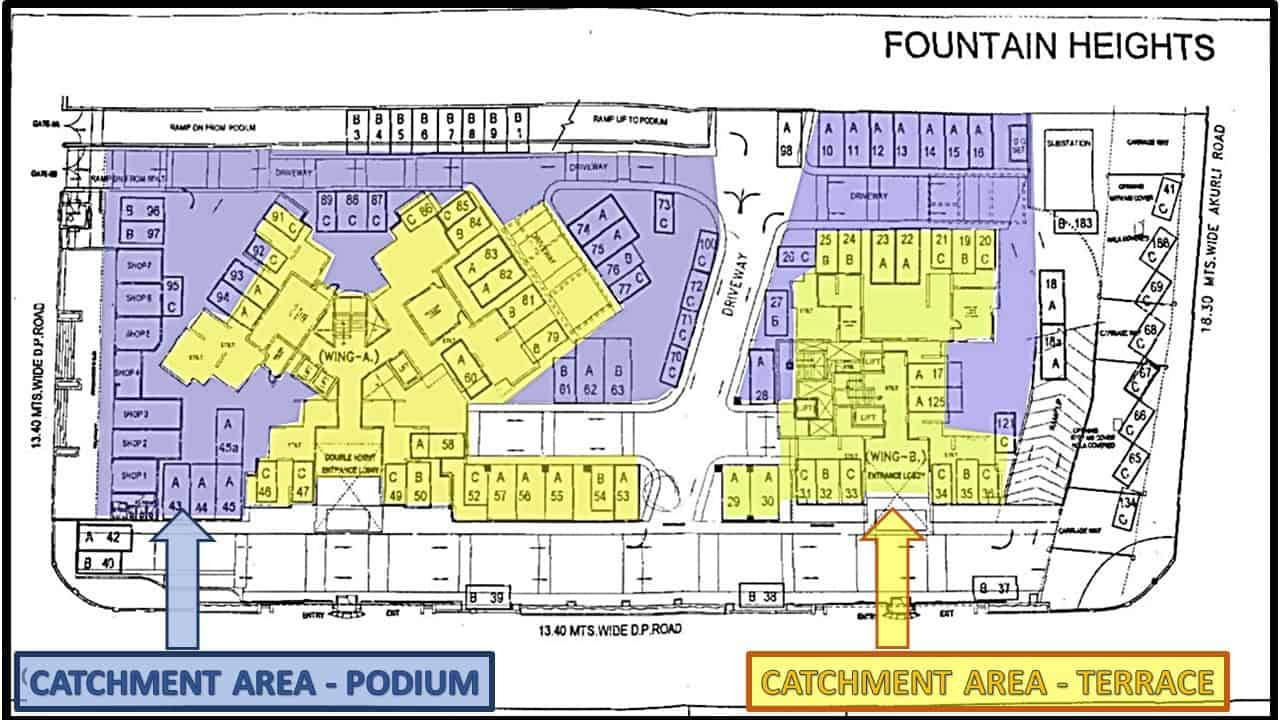
The building has two wings (called A and B) and in each we have two distinct catchment areas that are of RCC base – the terrace that is at the top of the residential tower, and the podium car park that is around the tower.

Water from parts of the terrace was already being directed to recharge pits. Despite this, there wasn’t much of a difference in the yields from the borewells in the monsoon, when one would expect them to be quite full. We needed to check why this was happening. Pending this, we decided not to attempt surface runoff harvesting.
We decided to focus on the rooftop, specifically the podium areas which are together approximately 670 sq m. Considering a moderate Mumbai Suburban monsoon of 2000 mm of rain, this area had the potential to harvest about 1340 kilolitres** of water.
** Rainwater Harvesting calculation thumb rule: A rainfall of 1 mm catches 1 litre of water for every 1 sq m (10.76 sf ft) of catchment area.
The system we implemented
Podium rainwater harvesting
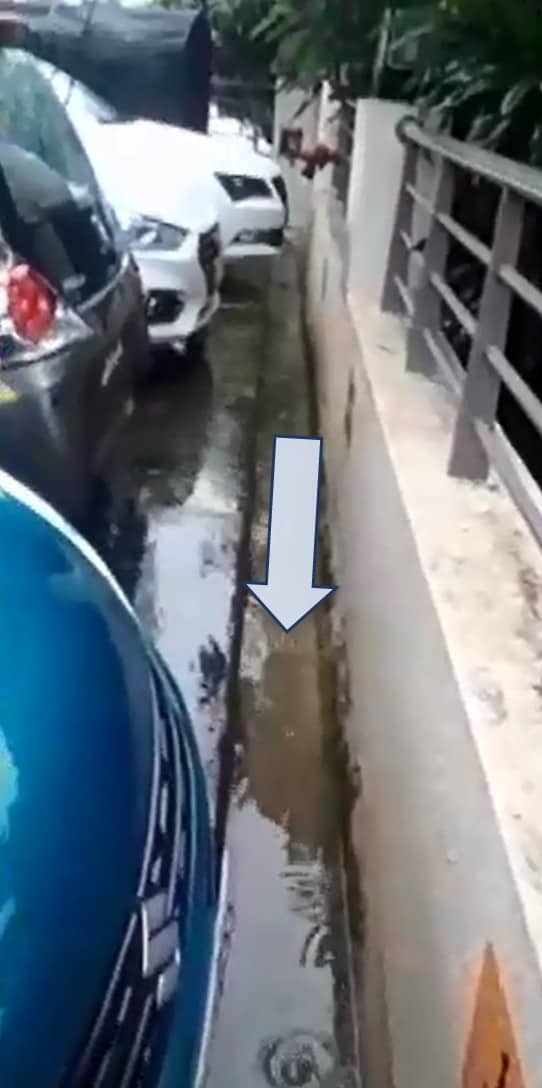
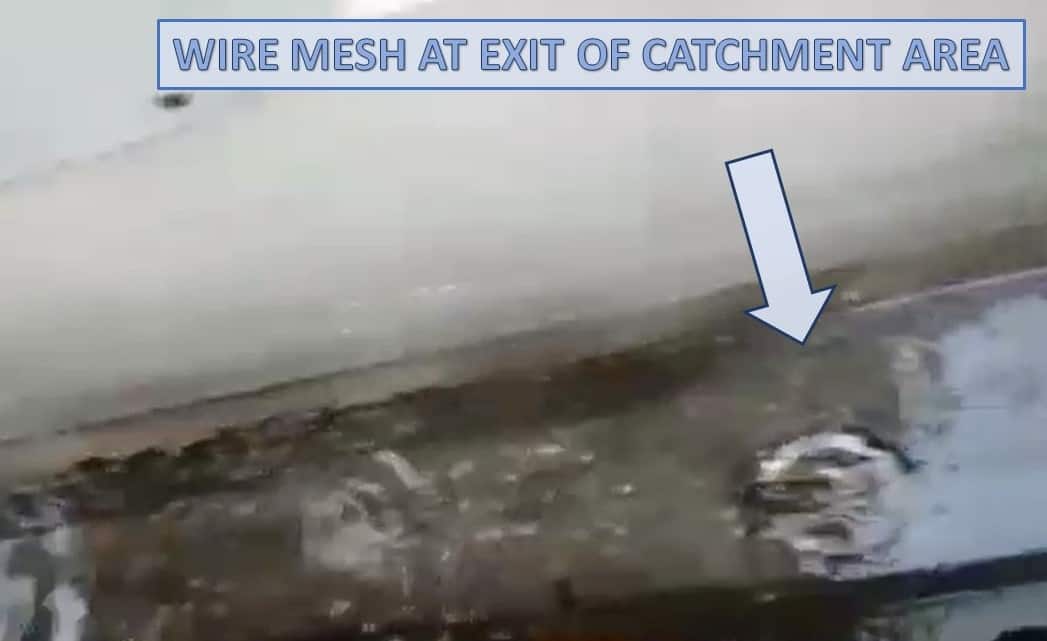
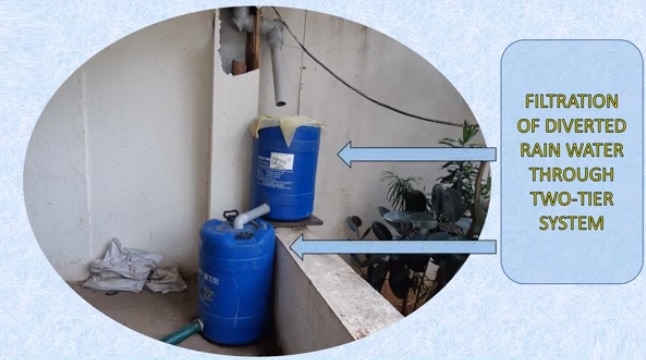
The filtration system comprises of nylon mesh, gravel and sand. The mesh prevents any gross organisms from entering. It must be cleaned daily during the season. Otherwise it will get clogged, leading to inefficient drainage and then overflowing of water from the filtering vessel. The gravel and sand helps in the removal of turbidity and water discoloration.

This water is utilised for non-potable purposes, such as flushing toilets and watering plants in the garden. It is pumped up to the specific overhead tanks.
After filling the available underground storage tank, the overflow is currently diverted to the recharge pits to revitalise the underground water level for the borewells.
This system handles the water from the podium of one wing. Similarly water from the other wing is also collected, but the filtration system is yet to be installed.
Ensuring flushing of the first shower water
When the first rains of the season happen, the water is not collected. Instead it is flushed out to avoid contaminating the storage of the rechargeable water. This is done using a first flush valve, which is installed in every pipeline before the water passes through the filters / enters the storage tanks. This also helps clearing off the silt that may be deposited on the catchment area in the pre-monsoon season.
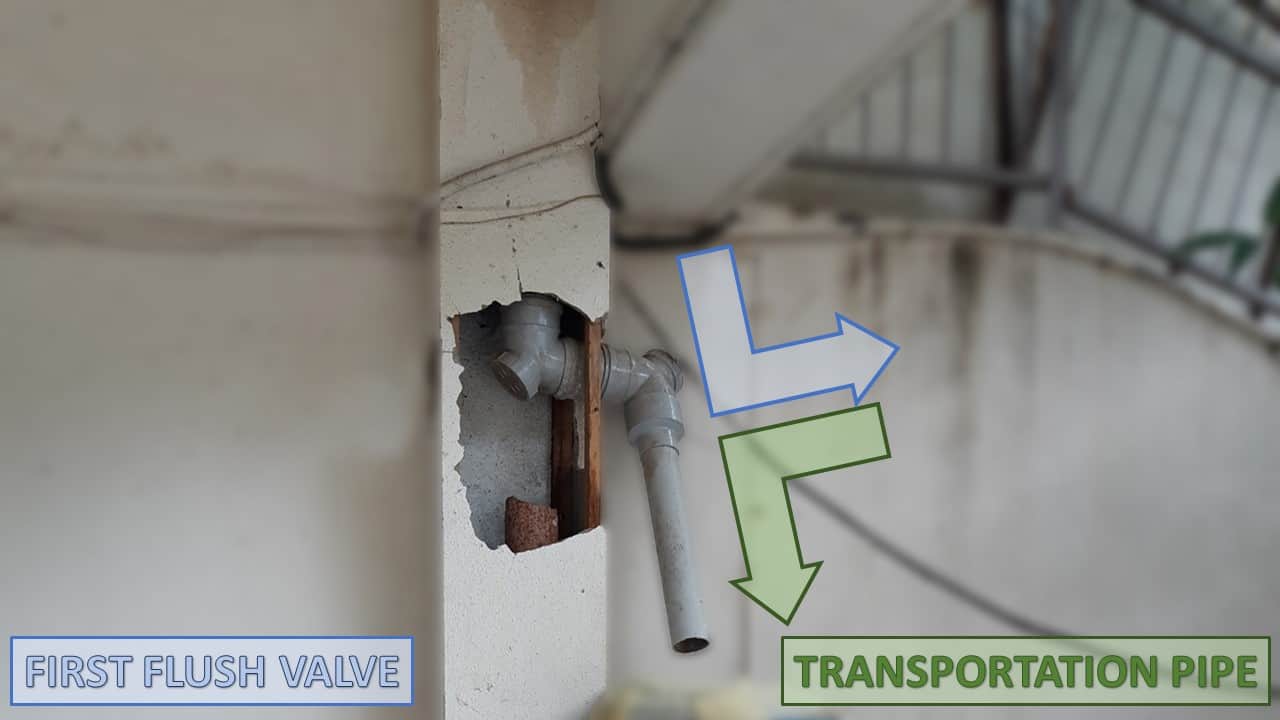
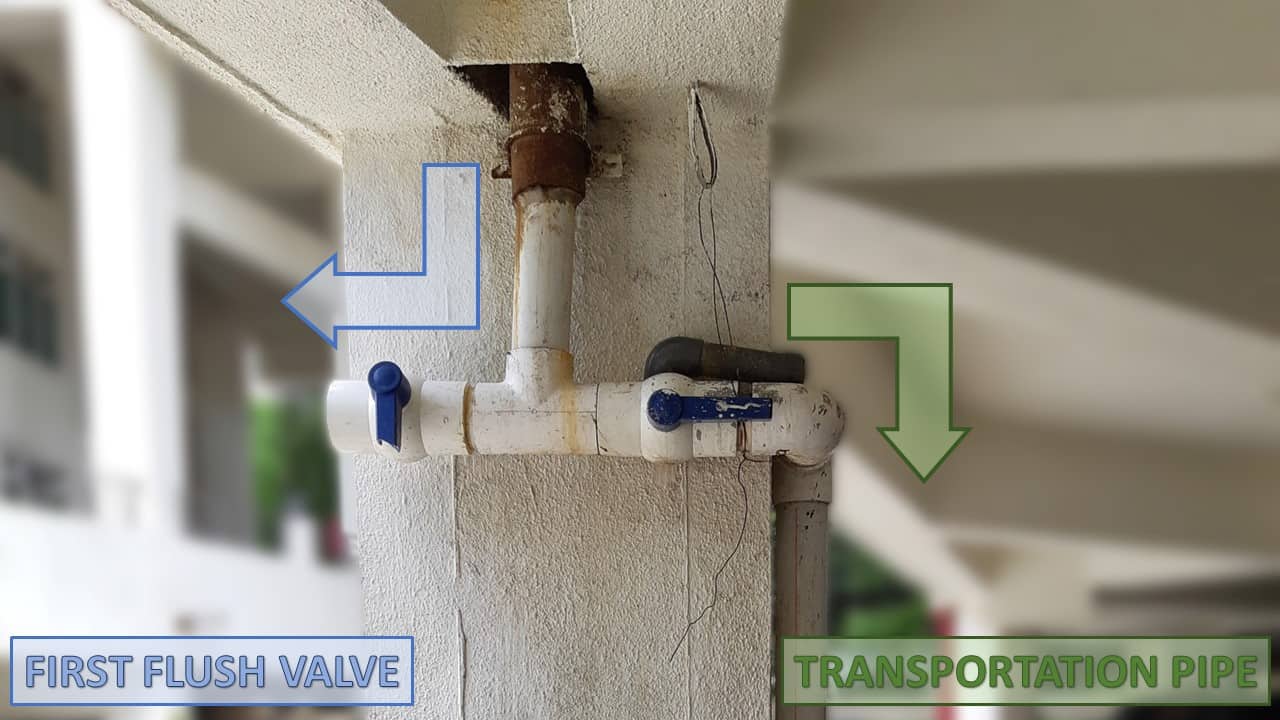
Swimming pool water recycling
We have diverted the water from the swimming pool filtration plant to recharge pits instead of draining it into the sewage line, thereby preventing this water loss that was happening every week.
Improvements to our initial system
Retrofitting anything in an existing building is usually a challenge. As is evident in the pictures, the entire water diversion system is open and visible, because it was done after the completion of the building. We had to tap the pipelines at certain places to divert the water the way we wanted it.
When we set this up about a year ago, we didn’t use any filter. So we had muddy water in the toilet flush. Also, too much of sediment in the underground tank caused blocking of the water pumps. This year (July 2020) we added the filtration system in a small space in the car parking area.
Cost of implementation
The only costs in implementing rainwater harvesting for the podium were: extension PVC pipes and valves, the filtration system, and renovation of the recharge pits – material and labour. We spent about Rs 25,000. Civil engineering support was provided by our estate manager and we had our in-house plumber to do the plumbing-related work.
Benefits of the new system
Our water supply is a mix of MCGM water, borewells and rainwater harvested water (dependent on the monsoons), and water tankers. We haven’t done a detailed analysis, but we know that our dependence on water tankers has decreased. We still need them through the year, but over the last year, we’re saving 5-10 water tankers every month. This despite water cuts by MCGM.
Future plans
1. We need to evaluate the efficiency of our recharge pits so that we know that water going here is actually feeding our borewells.
2. Till such time, storage of water is better guarantee than recharging. We want to install a bigger capacity storage tank so that we can store more of the rainwater during heavy rains for our future use, instead of sending this water to recharge pits.
3. We need to install a filtration system for one wing which has not been done as yet.
4. We need to relook at the terrace rainwater harvesting to get it to full potential.
5. We are looking to divert the water that falls in the open area (surface runoff) to recharge the groundwater level.
We are aware of the limitations of rainwater harvesting in high rise towers like ours – limited catchment area with the result that the quantity of water we can harvest would be only a small portion of our annual requirements. Still, with professional help, we hope that we will be able to upgrade our rainwater harvesting system and also find ways to become more water efficient, thereby reducing our water requirements.
The society office can be reached at fountainheights.mgr@gmail.com.
Related articles How this Bengaluru apartment cut water consumption by 52% with just three measures Replenish aquifers with rainwater harvesting Heavy rain, dams full to the brim, yet Pune citizens have to rely on costly tanker water A must-have checklist for apartment buyers as cities run dry In the news for heavy rains every year, why is Mumbai still water-deficient?
The society management is sensitive towards environment and cost effective measures in the interest of society. Very appreciable work. Trust they use it to full potential.
An excellent approach, Saluting team work. Jay Hind